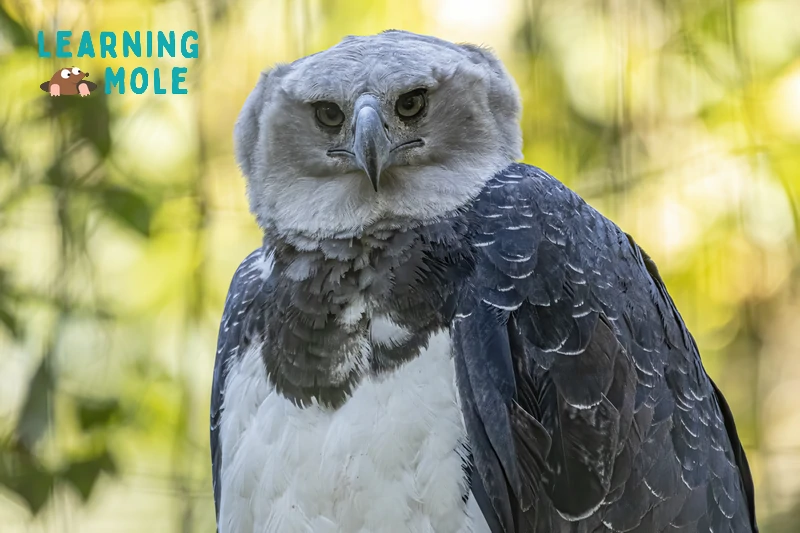
The Majestic Harpy Eagle: The Largest and Most Powerful Raptor in the World
Table of Contents
The Harpy Eagle, a master of silent flight and a formidable predator reigns supreme in the rainforest canopy. Its impressive wingspan and sharp talons inspire awe, yet its role extends beyond captivating sights. As an apex predator, the Harpy Eagle plays a vital role in maintaining the ecosystem’s health by regulating prey populations. This article investigates the captivating life of this majestic bird, exploring its hunting techniques, ecological importance, and the ongoing efforts to protect this endangered species.
The Largest and Most Powerful Raptor in the World
The Harpy Eagle is the largest and most powerful raptor in the world, boasting impressive size, weight, and hunting capabilities.
Size and Weight
The eagles are enormous and vital. They are the most giant and powerful birds of prey in the world. Some harpy eagles can weigh up to 20 pounds! Their body can go from about 35 to 41 inches long.
Their wing span reaches two meters wide! Also, they have substantial back talons that are four to five inches long. That’s almost as big as a human hand! This makes them great hunters in their home, the rainforests of Central and South America.
Appearance
It is one of the world’s largest and most potent raptors, making it truly impressive. The harpy eagle has a massive wingspan that reaches 7 feet, allowing it to soar high above the rainforest canopy.
Its body is covered in beautiful dark grey feathers, giving it a regal and distinguished look. One of its most distinguishing features is the large crest of feathers on its head, which gives it a unique and intimidating presence.
The harpy eagle has sharp nails around four to five inches long, perfect for capturing their prey with precision and strength.
This incredible bird’s appearance reflects its status as an apex predator in the rainforest ecosystem. The harpy eagle’s size and power make it a fantastic sight that captures the imagination of nature lovers worldwide.
Diet and Hunting Techniques

The Harpy Eagle boasts a diverse menu, predominantly featuring small to medium-sized mammals like sloths and monkeys. But this adaptable predator isn’t picky! Its prey list includes snakes, birds, reptiles, and other raptors like kites and hawks.
With an unmatched vantage point high in the rainforest canopy, the bird transforms into a patient observer. Its piercing yellow eyes scan the leafy jungle floor, meticulously detecting the slightest movement. Once a suitable target presents itself, the eagle springs into action.
Witnessing the Harpy Eagle’s hunting prowess is a testament to its perfect adaptation. Its large size and formidable grip ensure even the most agile creatures stand little chance against its grasp. This apex predator secures its meals with astonishing efficiency and maintains the delicate balance of the rainforest ecosystem.
Habitat and Distribution
The harpy eagle habituates in the rainforests of Central and South America. It is this region’s most giant and powerful bird of prey. You can spot them in places like the Pacaya Samiria Reserve, where they are known to thrive.
These majestic birds have adapted to live within the dense tropical forests, flying high above the canopy or perched on tall trees. They need these vast expanses of forest to hunt for their prey and raise their young. The harpy eagles’ habitat is essential to maintaining biodiversity and preserving wildlife in these regions.
Breeding and Family Life
They have a unique breeding and family life. They form lifelong bonds with their mates, and parents actively raise their young. After finding a suitable nest site high up in the rainforest canopy, the female lays one or two eggs.
The parents share roles in incubating the eggs for about 56 days until they hatch. Once the chicks are born, both parents work together to provide food and protect them from danger.
The young harpy eagles stay with their parents for about a year before venturing alone. It’s incredible how these majestic birds prioritise their family and work together to ensure the survival of their species.
Threats and Conservation Efforts of Harpy Eagle
Soaring through emerald skies, the Harpy Eagle embodies the power and awe of the rainforest. But its majestic flight faces turbulence. Below, we will chart the threats pushing this apex predator towards extinction and spotlight the tireless efforts to ensure its wings carry it into the future.
Threats
- Facing Deforestation: Half of Harpy Eagle’s rainforest home could vanish within 30 years. Logging and agriculture fragment hunting grounds and destroy nesting sites, jeopardising their survival.
- Disturbed by Humans: Noise and activity near nests disrupt breeding, pushing the Harpy Eagle further toward extinction.
- Misunderstood and Persecuted: Myths about livestock threats and child attacks fuel illegal hunting, adding to population decline.
Conservation Efforts
Listed as Near Threatened on the IUCN Red List, the Harpy Eagle fights for its future. Conservation efforts offer hope:
- Safe Havens: Sanctuaries like Panama’s Darién National Park and Guyana’s Harpy Eagle Reserve provide vital refuge.
- Community Champions: Collaborative projects with local communities promote ecotourism and sustainable forestry, protecting habitat while fostering understanding.
- Monitoring and Research: Dedicated groups track populations and study behaviours, informing effective conservation strategies.
Conservation Education and Awareness
Conservation education is essential to raise awareness about the threats the majestic harpy eagle faces. By educating people, we can help them understand the importance of protecting this incredible bird and its habitat.
We teach people about the harpy eagle’s significance in the ecosystem through workshops, seminars, and educational programs.
We can share interesting facts about its size and power as the largest raptor in the world. By highlighting its role as an apex predator in neotropical rainforests, we can emphasise its importance for biodiversity.
Moreover, by explaining its symbolism and significance in human culture and indigenous communities’ beliefs and traditions, we can connect on a deeper level with those who appreciate cultural heritage.
Through conservation education initiatives like guided tours or interactive exhibits focusing on wildlife protection efforts in their natural habitats, such as tropical rainforests or reserves like Pacaya Samiria Reserve, where they thrive, visitors can learn more about these magnificent creatures while experiencing firsthand their beauty within their natural environment.
The Eagle’s Role in the Ecosystem
The Harpy Eagle reigns as the rainforest’s apex predator, playing a crucial role:
- Balancing the Ecosystem: By hunting monkeys and sloths, they prevent overgrazing and ensure long-term rainforest health.
- Indicator of Hope: Their presence signifies a healthy ecosystem, urging us to protect the intricate web of life they hold in balance.
Symbolism in Human Culture
The Harpy Eagle holds significant symbolism and is vital in indigenous cultures. Its conservation education and awareness initiatives are making a positive impact on protecting this majestic raptor.
Find out more about its cultural significance and the efforts to protect it.
Symbolism and Significance
It is considered a mystical creature in many indigenous communities, representing strength, courage, and wisdom.
The bird’s majestic appearance and impressive hunting skills have inspired awe and reverence among people throughout history. Conservation efforts surrounding the harpy eagle also significantly educate the public about preserving wildlife and protecting their habitats.
By raising awareness about this magnificent raptor, we can contribute to safeguarding not only the harpy eagle but also the rich biodiversity of our planet’s rainforests.
Role in Indigenous Cultures

The harpy eagle holds a special place in the cultures of indigenous communities in Central and South America. It is often seen as a power, strength, and spirituality symbol. The harpy eagle’s majestic presence and fierce nature have made it an essential figure in their myths, legends, and artwork.
Indigenous people admire the birds’ hunting skills and consider them a guardian spirit of the rainforest. They believe encountering a harpy eagle brings good fortune or can be a warning sign.
In some cultures, its feathers are used for ceremonial purposes or to create decorative items. The significance of the harpy eagle in indigenous cultures highlights their deep connection with nature and emphasises the need to protect this magnificent species for future generations to appreciate.
Conclusion
While the Harpy Eagle embodies the power and grandeur of the rainforest, its future remains uncertain. Habitat loss, human encroachment, and illegal hunting jeopardise the survival of this iconic bird. By supporting conservation initiatives and advocating for responsible land use, we can collectively ensure the Harpy Eagle’s soaring flight echoes through the rainforest canopy for generations.
FAQs
Can I see a Harpy Eagle in person?
Observing it in the wild is challenging due to its low population density and shy nature. Some zoos and wildlife sanctuaries in Central and South America house these majestic birds, offering opportunities for up-close encounters.
Where can I learn more about Harpy Eagles?
Numerous reputable organisations like the IUCN, World Wildlife Fund, and The Peregrine Fund provide information and resources about Harpy Eagles and their conservation. Documentaries and educational websites offer further insights into these fascinating creatures.
What makes the Harpy Eagle so unique?
The Harpy Eagle is the largest and most powerful raptor in the Western Hemisphere, boasting a wingspan reaching up to 7 feet and nails capable of crushing bone. Its powerful eyesight allows it to spot prey from high in the rainforest canopy, and its silent flight ensures a successful ambush. It plays a crucial role in maintaining rainforest ecosystems by keeping prey populations in check, contributing to overall biodiversity.
Where do Harpy Eagles live?
Harpy Eagles primarily reside in the rainforests of Central and South America, from Mexico to Argentina. They prefer undisturbed, mature forests with tall trees for nesting and hunting.


Leave a Reply